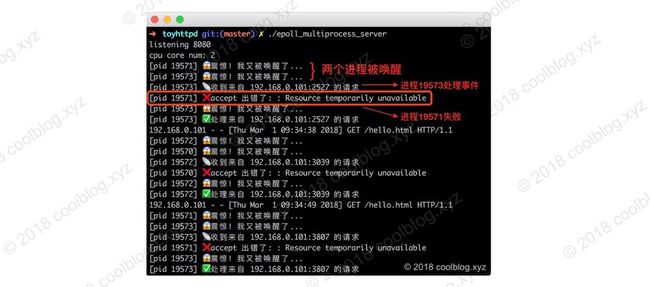基于epoll实现简单的web服务器
1. 简介
epoll 是 Linux 平台下特有的一种 I/O 复用模型实现,于 2002 年在 Linux kernel 2.5.44 中被引入。在 epoll 之前,Unix/Linux 平台下的 I/O 复用模型包含 select 和 poll 两个系统调用。随着因特网的发展,因特网的用户量越来越大,C10K 问题出现。基于 select 和 poll 编写的网络服务已经不能满足不能满足用户的需求了,业界迫切希望更高效的系统调用出现。在此背景下,FreeBSD 的 kqueue 和 Linux 的 epoll 被研发了出来。kqueue 和 epoll 的出现,终结了 C10K 问题,C10K 问题就此作古。
因为 Linux 系统的广泛应用,所以大家在说 I/O 复用时,更多的是想到了 epoll,而不是 kqueue,本文也不例外。本篇文章不会涉及 kqueue,大家有兴趣可以自己看看。
2. 基于 epoll 实现 web 服务器
在 Linux 中,epoll 并不是一个系统调用,而是 epoll_create、epoll_ctl 和 epoll_wait 三个系统调用的统称。关于这三个系统调用的细节,这里就不说明了,大家可以自己去查 man-page。接下来,我们来直接看一个例子,这个例子基于 epoll 和 TinyHttpd 实现了一个 I/O 复用版的 HTTP Server。在上代码前,我们先来演示这个玩具版 HTTP Server 的效果。
上面就是玩具版 HTTP Server 的运行效果了,看起来还行。在我第一次把它成功跑起来的时候,感觉很奇妙。好了,看完效果,接下来看代码吧,如下:
#include 上面的代码有点长,不过还好,基本上都是模板代码,没什么特别复杂的逻辑。希望大家耐心看一下。
上面的代码基于epoll + 多进程的方式实现,开始,主进程会通过系统调用获取 CPU 核心数,然后根据核心数创建子进程。为了演示“惊群现象”,这里多创建了一倍的子进程。关于惊群现象,下一章会讲到,大家先别急哈。创建好子进程后,主进程不需再做什么事了,核心逻辑都会在子线程中执行。首先,每个子进程都会调用 epoll_create 在内核创建 epoll 实例,然后再通过 epoll_ctl 将 listen_fd 注册到 epoll 实例中,由内核进行监控。最后,再调用 epoll_wait 等待感兴趣的事件发生。当 listen_fd 中有新的连接时,epoll_wait 会返回。此时子进程调用 accept 接受连接,并把客户端 socket 注册到 epoll 实例中,等待 EPOLLIN 事件发生。当该事件发生后,即可接受数据,并根据 HTTP 请求信息返回相应的页面了。
这里说明一下,上面代码中处理 HTTP 请求的逻辑是写在 TinyHttpd 项目中的,TinyHttpd 是一个只有 500 行左右的超轻量型Http Server,很适合学习使用。为了适应需求,我对其源码进行了一定的修改,并添加了一些注释。本章的测试代码已经放到了 github 上,需要的同学自取,传送门 -> epoll_multiprocess_server.c。
3. 惊群及演示
“惊群现象”是指并发环境下,多线程或多进程等待同一个 socket 事件,当这个事件发生时,多线程/多进程被同时唤醒,这就是“惊群现象”。对应上面的代码,多个子进程通过调用 epoll_wait 等待 listen_fd 上某个事件发生。当有新连接进来时,多个进程会被同时唤醒去处理这个事件。但最终只有一个进程可以去处理事件,其他进程重新进入等待状态。使用上面的代码可以演示惊群现象,如下:
从上图可以看出,当 listen_fd 上有新连接事件发生时,进程19571和19573被唤醒。但最终进程19573成功处理了新连接事件,进程19571则失败了。
惊群现象会影响服务器性能,因为多个进程被唤醒,但最终只有一个进程可以成功处理事件。而 CPU 需要为一个事件的发生调度数个进程,因此会浪费 CPU 资源。
对于惊群现象,处理的思路一般有两种。一种是像 Lighttpd 那样,无视惊群。另一种是像 Nginx 那样,使用全局锁避免惊群。简单起见,本文测试代码采用的是 Lighttpd 的处理方式,即无视惊群。对于这两种思路的细节,由于本人未读过两个开源软件的代码,这里就不多说了。如果大家有兴趣,可以参考网上的一些博文。
4. 总结
epoll 是 I/O 复用模型重要的一个实现,性能优异,应用广泛。像 Linux 平台下的 JVM,NIO 部分就是基于 epoll 实现的。再如大名鼎鼎 Nginx 也是使用了 epoll。由此可以看出 epoll 的重要性,因此我们有很有必要去了解 epoll。本文通过一个测试程序简单演示了一个基于 epoll 的 HTTP Server,总体上也达到了学习 epoll 的目的。大家如果有兴趣,可以下载源码看看。当然,纸上学来终觉浅,还是要自己动手写才行。本文的测试代码是本人现学现卖写的,仅测试使用,写的不好的地方望谅解。
好了,本文到此结束,谢谢阅读!
参考
- 关于多进程epoll与“惊群”问题 - CSDN
- “惊群”,看看nginx是怎么解决它的 - CSDN
- 高性能网络编程(二):上一个10年,著名的C10K并发连接问题
本文在知识共享许可协议 4.0 下发布,转载需在明显位置处注明出处
作者:coolblog
本文同步发布在我的个人博客:http://www.coolblog.xyz
![]()
本作品采用知识共享署名-非商业性使用-禁止演绎 4.0 国际许可协议进行许可。

